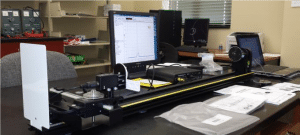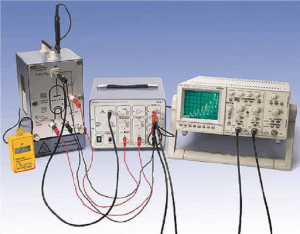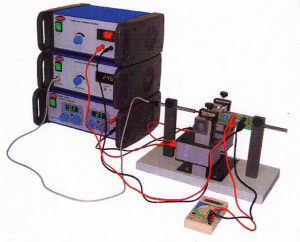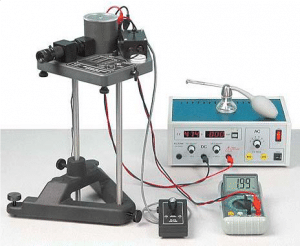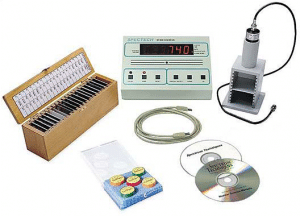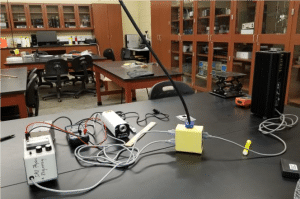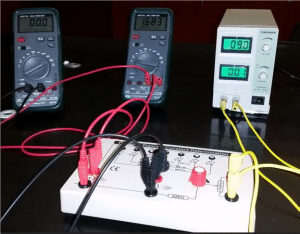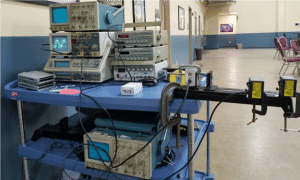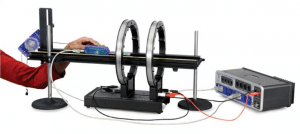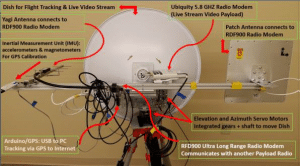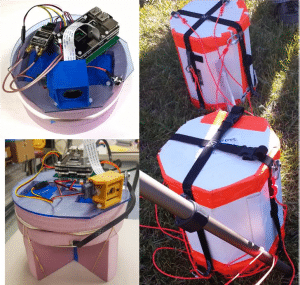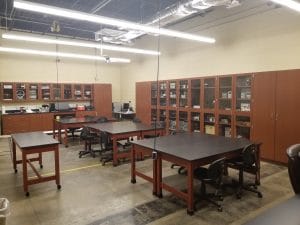
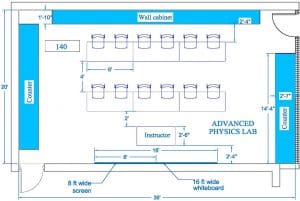 The Advanced Physics Lab facilitates faculty research work and project work undertaken by students. The laboratory is well equipped to support undergraduate education and research. The lab is used to introduce students to the equipment and techniques of experimental physics. The space also serves as a hub for undergraduate research in physics.
The Advanced Physics Lab facilitates faculty research work and project work undertaken by students. The laboratory is well equipped to support undergraduate education and research. The lab is used to introduce students to the equipment and techniques of experimental physics. The space also serves as a hub for undergraduate research in physics.
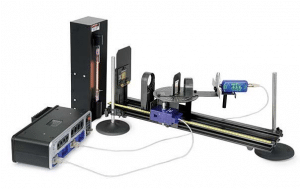 Atomic Spectra Using Spectrophotometer
Atomic Spectra Using Spectrophotometer
In this experiment designed for use with PASCO Capstone software, the wavelengths of the discrete lines of the atomic spectra of various gases are measured using a grating spectrophotometer. The wavelengths of the spectral lines are compared to the accepted values and, in the case of Hydrogen, the electron orbit transitions corresponding to the lines are identified. The open construction of this spectrophotometer allows students to see the entire spectrum while the intensity versus angle is graphed in real-time.
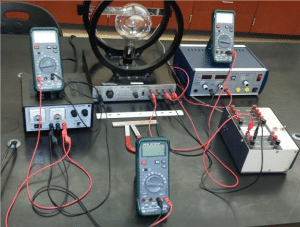 Measuring electron’s e/m. JJ Thomson Tube
Measuring electron’s e/m. JJ Thomson Tube
This The Charge-to-Mass Ratio System reproduces one version of J.J. Thomson’s landmark experiment, providing an accurate measurement of the charge-to-mass ratio of an electron. And, since the electron tube can be rotated through 90°, students can also make a more general study of the behavior of electrons in a magnetic field. This apparatus also has deflection plates so students can study the effect of an electric field on moving electrons.
 Interference & Diffraction of Light Experiment
Interference & Diffraction of Light Experiment
In this experiment interference and diffraction patterns from laser light passing through various single-slits and multiple-slits are scanned and plotted in real-time. The distances between the central maximum and the diffraction minima for a single slit are measured. These measurements are compared to theoretical values.
 Franck-Hertz Experiment
Franck-Hertz Experiment
Franck and Hertz first performed the important experiment demonstrating discrete energy states in atoms. This experiment demonstrates the quantization of energy and enables the recording and evaluation of spectra. The system includes the Franck-Hertz tube with mercury filling heater, as well as power supply. A dual beam analog oscilloscope with x-y is used to observe the maxima in the Franck Hertz trace.
 Hall Effect Apparatus
Hall Effect Apparatus
The apparatus is used to determine the Hall voltage developed across germanium crystal on circuit board. Students also calculate the Hall coefficient and the carrier concentration of the sample material. Apparatus is made out of two solenoids, constant current supply, and Digital gauss meter. This is an iconic experiment in solid-state physics and conduction phenomena. Hall Effect sensors are everywhere from automobiles to mobile phones.
 Millikan Oil Drop Apparatus
Millikan Oil Drop Apparatus
In this experiment, small droplets of oil are introduced into a chamber where an electric field of known strength is present. Using the viewing scope and a stopwatch, the velocity of a falling oil droplet is measured and recorded. Next, the electric field in the chamber is increased, causing the oil droplet to move upward. This allows the measurement of the force on the droplet, the charge of the droplet, and ultimately the charge of an electron.
 Nuclear Laboratory and Radioactivity
Nuclear Laboratory and Radioactivity
This stand-alone Geiger-Muller System provides a wide range of experiments with alpha, beta, and gamma radiation. Includes a versatile scaler, a G-M Tube with a mount and trays, and a full set of radioactive sources and absorbers. Students test 1/r2 Law, find out background radiation, experiment with radiation absorption and explore shielding.
 Photoelectric Effect
Photoelectric Effect
Albert Einstein received the Nobel Prize for explaining the photoelectric phenomena. Students verify that when Electromagnetic Radiation interacts with electrons within metals it gives the electrons increased kinetic energy. Light can give electrons enough extra kinetic energy to allow them to escape the metal surface. We call the ejected electrons photoelectrons. Applying the conservation of energy, students are able to calculate Plank’s fundamental constant.
 Physics Light Emitting Diode
Physics Light Emitting Diode
When we apply a large enough potential difference across a light-emitting diode (LED), it emits photons that all have the same frequency. When the LED just begins to glow, the energy E lost by each electron as it passes through the LED is converted into the energy of a single photon. Plotting ΔV against the frequency of light for LEDs of several different colors produces a straight line of slope that is compared to Plank Constant overcharge of the electron from theory.
 Speed of Light Setup
Speed of Light Setup
A function generator powers with a square signal a diode to emit a narrow laser beam. Light is reflected from a mirror. A light receiver is designed for receiving the video signals transmitted via modulated light. The +127 mm lens is used to focus the light onto the element of the receiver. The two electrical pulses (the original square signal and the received sin signal) can then be displayed on an oscilloscope screen. Measuring the time delay (shift between the two crests) enables calculation of the speed of the light.
 Magnetic Field of Coils
Magnetic Field of Coils
The magnetic fields of various coils are plotted versus position as the Magnetic Field Sensor is passed through the coils, guided by a track. It is particularly interesting to compare the field from Helmholtz coils at the proper separation of the coil radius to the field from coils separated at less than or more than the coil radius. The magnetic field inside a solenoid can be examined in both the radial and axial directions.
 Satellite Tracking Ground Station
Satellite Tracking Ground Station
The Ground Station Tracking System receives scientific data during high altitude balloon flights, receives live video stream being transmitted at 5.8 GHz with the dish antenna, communicates with the still image payload at 900 Mhz using a patch (flat square). The video feed is then uploaded onto the internet for near real-time viewing. The ground station collects GPS data points and uses them to automatically adjust the antennas accordingly towards the balloon.
 High Altitude Balloon Payloads
High Altitude Balloon Payloads
The still image payload uses a Raspberry Pi and Pi Camera to take, store and transmit images. Transmitting images to the ground station is accomplished using a 900Mhz modem that also allows the user to indirectly send commands to the Pi such as changing camera settings, selecting images to be transmitted and tilting the camera vertically. The video payload uses a Raspberry Pi and Pi Camera to record HD video while transmitting the feed to the ground station The tracking payload houses a NAL Iridium satellite modem that allows for near real-time tracking of the balloon. SAU students put the setup together which can now used for future earth stratosphere exploration

